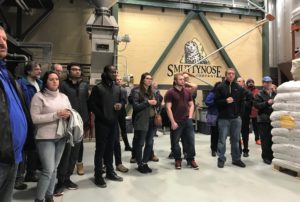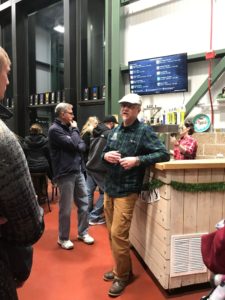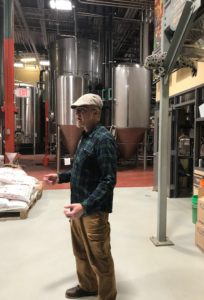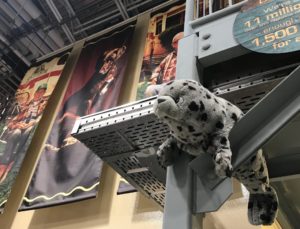IEEE-NH SMUTTYNOSE Tour – December 5th, 2018
For their 5th Annual “Science of” Networking Meeting, IEEE NH held a brewery tour event at Smuttynose in Portsmouth to discover the Science of Brewing Beer. Attended by 40 members, some of whom traveled as far as Boston, this networking event was quite the party. It started with excellent Smuttynose samples, was led by Smuttynose Production Manager, and finished with great foods and flights.
At the start, members warmed up and greeted each other while enjoying samples of Smuttynose Cherry Sour, S’Muttonators, and Rocky Road. Once the tour guide, Steve Schmidt, officially started the tour, we were led into a room with stacks of barley and machines that process this essential ingredient. Steve Schmidt was an extremely knowledgeable tour guide with an educational pedigree that would impress any beer expert. Apparently, the University of California-Davis grants diplomas in Brewing Operations! While his work experience is very diverse, he spent quite some time sharing stories from Meantime Brewing in Greenwich, London. To assure the best quality product, he would inspect the quality of barley to assure the harvest was ready.
That man loves his barley and claims that its contribution to the brewing process is underrated. According to Steve, malted barley gives beer its color, malty sweet flavor, dextrin to give the beer body, and the natural sugars needed for fermentation. Barley’s role in beer making is equivalent to grapes’ role in winemaking: fundamental. Before barley grain can be used to make beer, it must undergo a process known as malting, in which moisture stimulates the natural germination process inside the grain. Although barley is the most commonly used grain in beer making, many brewers use additional grains, such as wheat, oats, or rye, to imbue their beer with different flavors.
After his lecture about barley, the tour continued with the other machines necessary in the process. The giant beer fermenters were self-explanatory. After fermentation which takes 1-2 weeks for most ales and about 2 months for most lagers, the liquid requires filtering. In the “old days” brewers would wait until the sediment settled. For some of the beers, they still follow the traditional ways of brewing the beers. This mainly involved letting the beers boil for certain amounts of time and is the way that most of the Belgian beers are brewed. Some brewers use clarifiers. Smuttynose invested in a beer centrifuge to make the beer crystal clear.
After the beer is filtered and clear, the last step is bottling. While most of Smuttynose product is bottled, they are experimenting with canning. Canned beer is gaining popularity as it protects the product from sunlight and easier to carry. Canning technology has improved and gone are the days where the can would leave a metallic aftertaste. While Smuttynose is excited to experiment with canning, the bottling machine is 5x faster than the canning one.
Overall, the tour was very informative and fun. Smuttynose has a unique, friendly, and quirky culture. which transfers into their beers.




